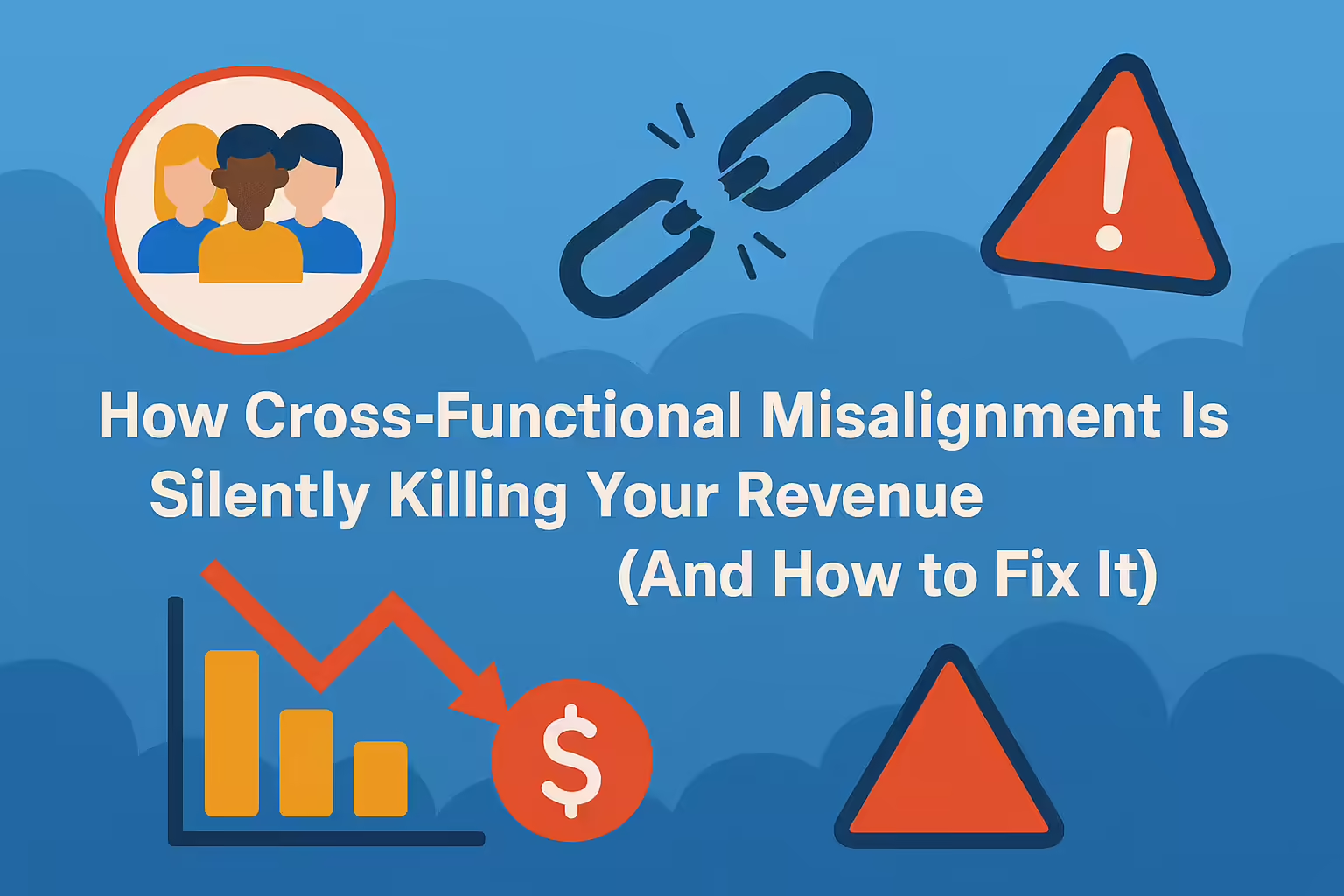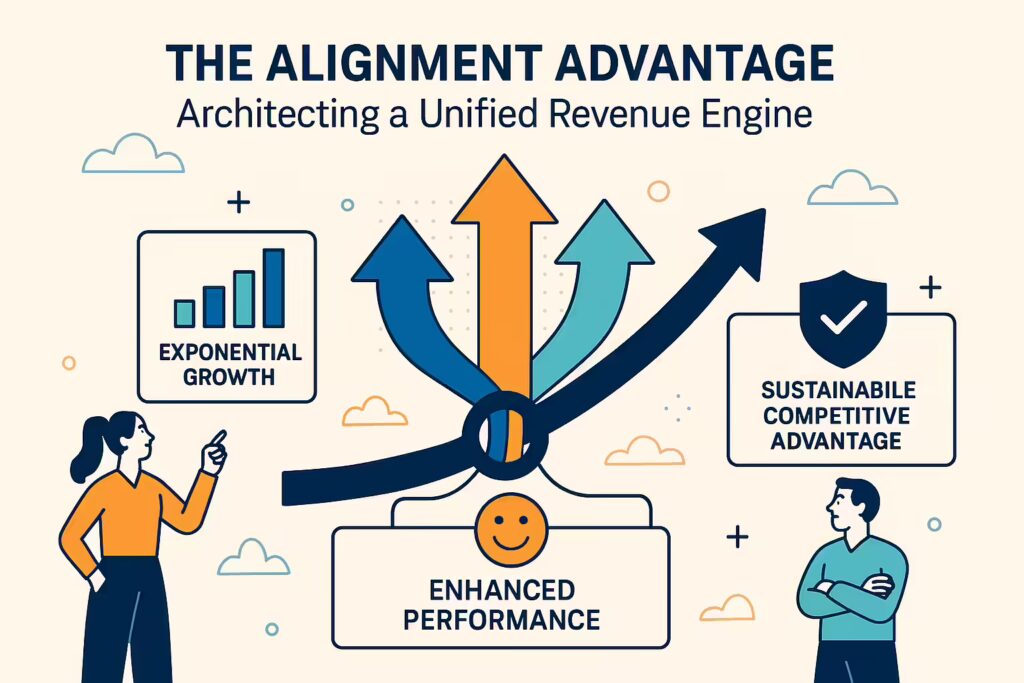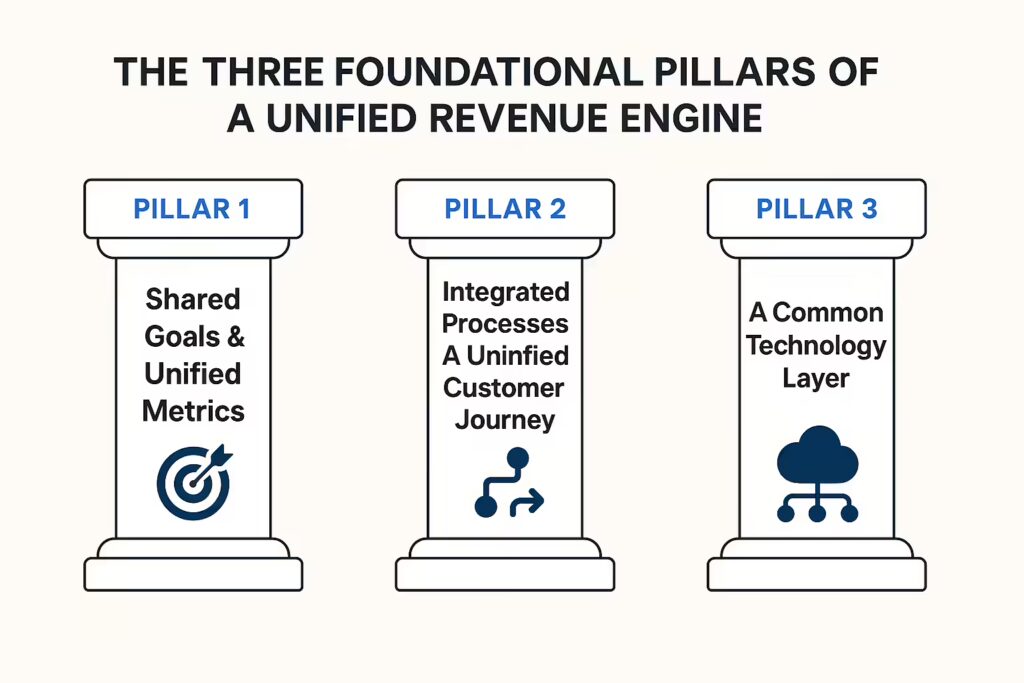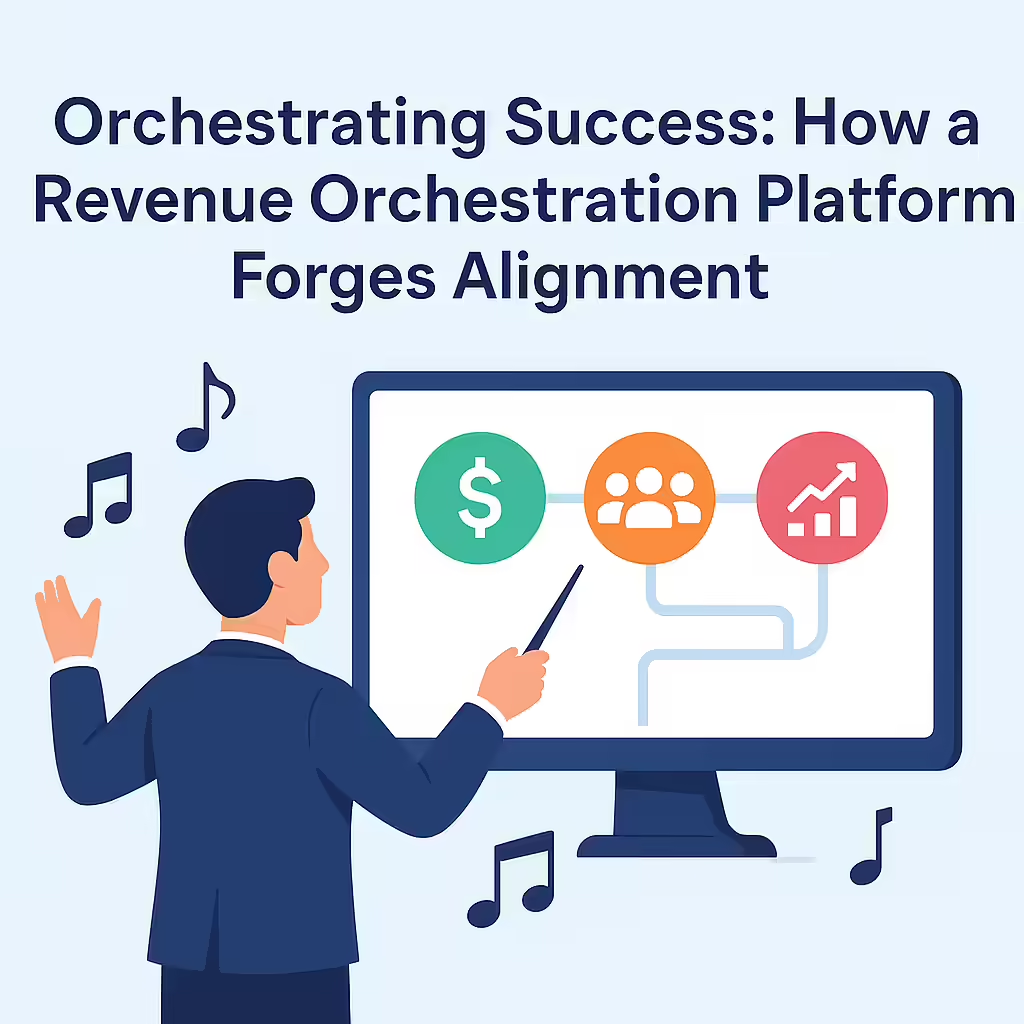The New Mandate for Growth is Alignment
In the modern executive suite, a dangerous perception gap has formed. It is a chasm between what leadership believes to be true about their organization’s operational harmony and the dissonant reality experienced by the teams on the front lines. Recent Forrester research starkly illustrates this divide: while an overwhelming 82% of C-level executives report that their product, sales, and marketing teams are aligned, a contradictory 65% of the sales and marketing professionals within those same organizations state there is a significant lack of alignment between their leaders. This is not a minor discrepancy; it is a critical strategic blind spot.
This internal disconnect has become an existential threat in an era where the customer’s path to purchase is no longer a predictable, linear funnel. The modern B2B buying process now resembles a “cyclone,” an unpredictable storm of touchpoints where buyers move in and out of engagement unpredictably. According to Gartner, today’s buyers spend a mere
17% of their time meeting with potential vendors. The other 83% of their decision-making journey happens in the digital ether—on websites, in peer reviews, and through interactions with marketing content. When an organization’s internal structure is fragmented, it projects a confusing, disjointed, and untrustworthy experience to the very buyers it aims to attract. Every point of internal friction is exported directly to the customer.
In this new landscape, the traditional model of siloed Sales, Marketing, and Customer Success departments is not just inefficient; it is obsolete. Sustainable, predictable growth is no longer the responsibility of a single department but the unified output of a single, cohesive “Revenue Team.” This report will build an evidence-based business case for this new paradigm. First, it will quantify the immense, often-hidden costs of departmental misalignment—a problem that silently siphons over $1 trillion from U.S. businesses annually. Second, it will outline the transformative financial and operational advantages of achieving true cross-functional alignment. Finally, it will provide a strategic blueprint for operationalizing this alignment through a central technology layer: a ReRevenue Orchestration PlatformAs a powerful consolidated communications platform, Kixie is engineered to empower revenue teams to work better together, transforming discord into a powerful engine for growth.
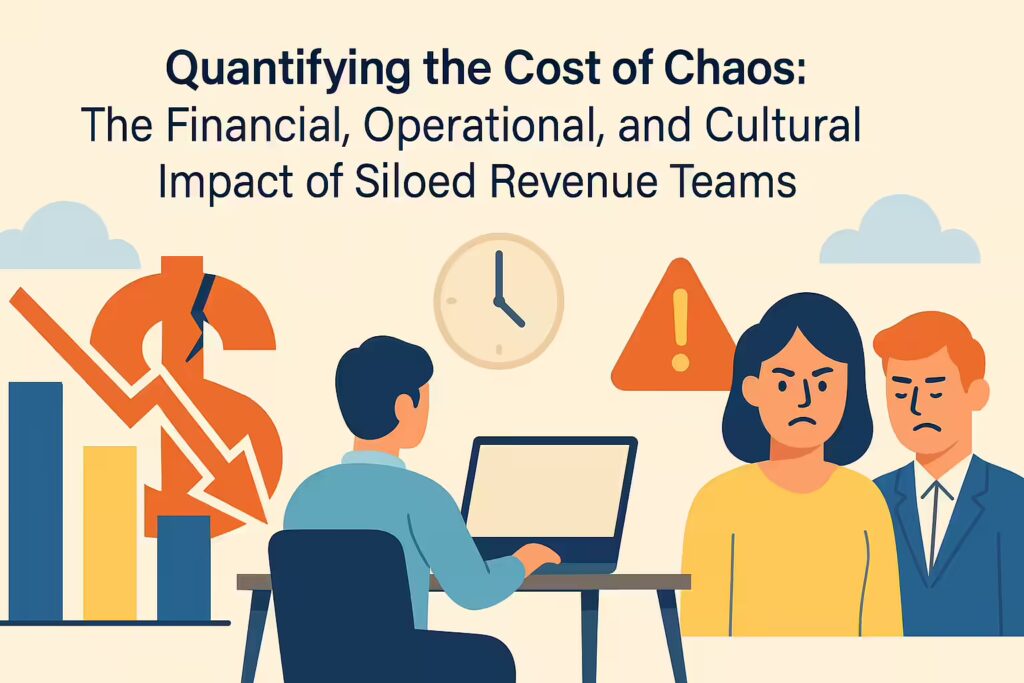
Quantifying the Cost of Chaos: The Financial, Operational, and Cultural Impact of Siloed Revenue Teams
For decades, interdepartmental friction has been dismissed as a “soft” cultural issue or an unavoidable cost of doing business. However, extensive research reveals a different reality: misalignment is a hard financial liability with staggering, quantifiable costs that directly erode profitability, cripple operational efficiency, and damage a company’s most valuable assets—its customers and its talent. For any executive focused on the bottom line, understanding these costs is the first step toward recognizing the urgent need for a new, unified approach.
The Trillion-Dollar P&L Leak: Direct Financial Consequences
The most compelling reason for leadership to address misalignment is its direct and devastating impact on financial performance. The disconnect between sales and marketing alone is estimated to cost businesses more than $1 trillion each year in the U.S.. This is not a theoretical number; it represents lost productivity, wasted marketing budgets, and unrealized sales potential. For B2B companies, this friction translates into a loss of
10% or more of annual revenue. For a billion-dollar enterprise, this is a self-inflicted wound of $100 million or more, year after year. Companies with poor alignment see their revenue decline by an average of 4% annually, while their aligned competitors surge ahead.
The impact extends beyond top-line revenue to the core of profitability. A landmark study by LSA Global found that highly aligned organizations are 72% more profitable than their misaligned counterparts. This data reframes alignment not as a cost center, but as one of the most powerful levers an executive can pull to directly improve margins and deliver sustainable financial health. The cost of inaction is not just stagnant growth; it is a direct and continuous drain on the company’s profitability.
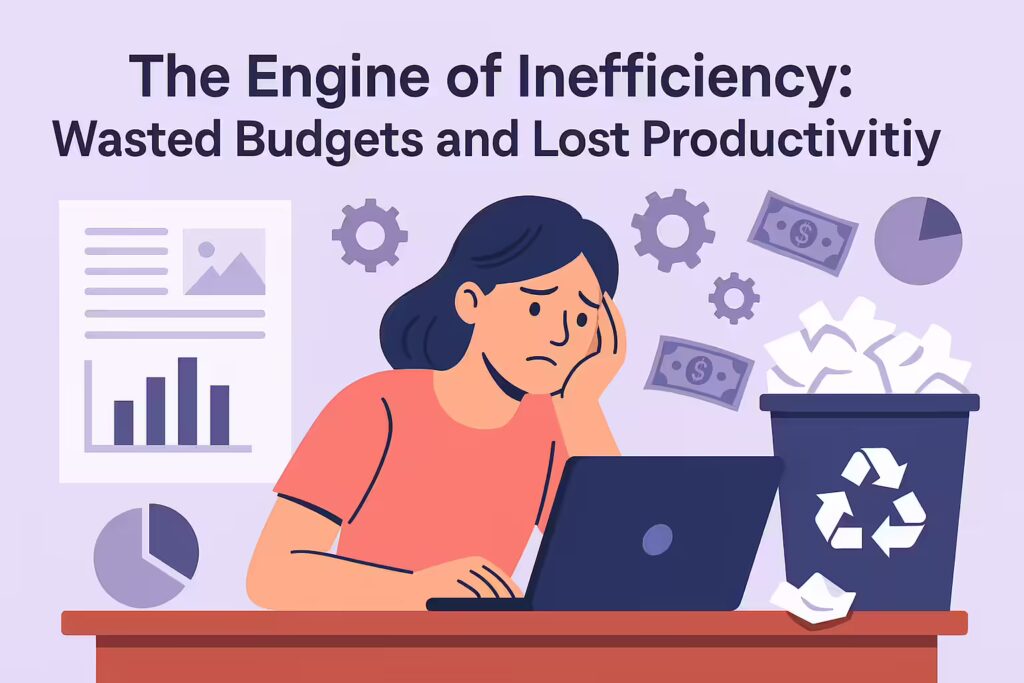
The Engine of Inefficiency: Wasted Budgets and Lost Productivity
Beneath the top-line financial figures lies a sprawling engine of operational inefficiency fueled by departmental silos. This waste manifests in both squandered budgets and lost human potential.
A significant black hole for resources is marketing content. An estimated 60-70% of B2B marketing content is never used by sales teams. Marketing departments invest heavily in creating white papers, case studies, and blog posts that they believe are valuable, yet these assets often die on the vine, unused. The root cause is a fundamental disconnect: sales teams frequently find the content to be irrelevant to the real-world conversations they are having with buyers. This represents a massive portion of the marketing budget that generates zero return.
This inefficiency cascades directly into the sales process through what has been termed the “MQL industrial complex”. Marketing teams, often incentivized by the volume of Marketing Qualified Leads (MQLs), flood the pipeline with contacts that are not ready for a sales conversation. The data is damning:
79% of marketing leads never convert into sales, and sales reps consequently
ignore up to 50% of the leads passed to them. According to a HubSpot survey, a mere
9.1% of salespeople rate the leads they receive from marketing as “very high quality”. This forces highly compensated sales professionals to spend their valuable time on unproductive prospecting, sifting through low-quality leads instead of focusing on what they do best: selling.
This operational friction culminates in a massive productivity drain across the organization. Research shows that U.S. employees spend an average of 2.1 hours per week embroiled in conflict, which amounts to a staggering $359 billion in paid hours annually that are spent on internal friction rather than productive work. This directly impacts the efficiency of the revenue engine. With sales reps spending only
33% of their time actively selling, the rest is consumed by administrative tasks and navigating the fallout of internal process failures.
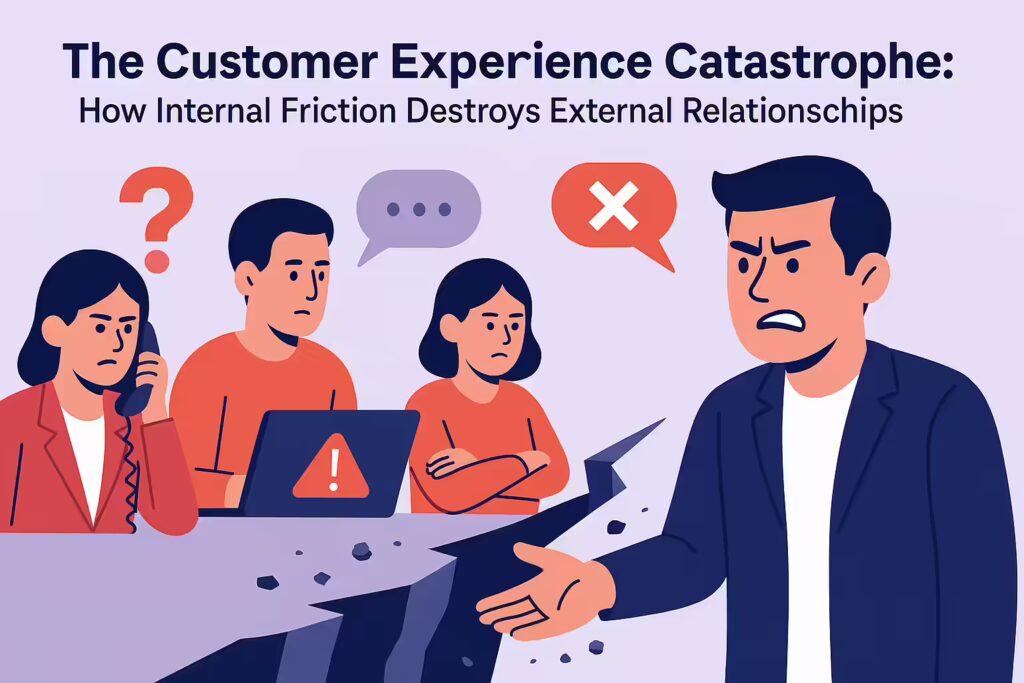
The Customer Experience Catastrophe: How Internal Friction Destroys External Relationships
The most dangerous consequence of internal misalignment is that it is not an internal problem. The chaos, confusion, and friction are directly exported to the customer, creating a fragmented and frustrating experience that actively drives them away.
Customers expect to interact with a brand as a single, cohesive entity. Instead, when they engage with a siloed organization, they are forced to navigate its dysfunctional internal structure. They are asked to repeat their account information and re-explain their problems as they are passed from a sales representative to a customer success manager, or from a web chat to a support call. They receive inconsistent messaging, hearing one value proposition in a marketing email and a completely different one in a sales pitch. This inconsistency doesn’t just cause frustration; it fundamentally erodes trust and can damage brand credibility by over 50%.
The handoff from a closed deal in sales to onboarding in customer success is a particularly notorious failure point. When a CS manager receives a new account without the proper context from pre-sale conversations, the customer’s Time to Value (TTV) is significantly lengthened. The initial excitement and momentum from the sale quickly wane into frustration as the customer realizes the team responsible for their success has no idea what was promised to them.
This poor experience is a direct driver of customer churn. The financial impact is severe: customer churn costs the average mid-market company $5.5 million per year. A stunning
49% of customers report having left a brand due to a poor customer experience, and 89% have switched to a competitor after such an incident. This directly attacks a company’s base of recurring revenue and diminishes Customer Lifetime Value (CLV), the lifeblood of any modern business.

The Cultural Corrosion: Morale, Burnout, and Talent Drain
Finally, the persistent friction between siloed departments cultivates a toxic internal culture that undermines the organization’s greatest asset: its people. Misalignment inevitably breeds a culture of blame and finger-pointing. The sales team complains that marketing leads are worthless, while the marketing team grumbles that the sales team can’t close deals. This adversarial dynamic leads to widespread employee frustration, disengagement, and burnout.
The financial consequences of this cultural decay are very real. Disengaged employees cost their companies an average of 18% of their annual salaries in lost productivity. Furthermore, the cost of replacing an employee who leaves due to conflict-driven burnout is substantial, reaching as high as
150% of their annual salary for a mid-level role. With U.S. companies facing a
10.5% chance of an employment lawsuit, often stemming from internal disputes, the cost of a toxic, misaligned culture extends into significant legal and financial risk.
The operational chaos of misalignment is not merely an inconvenience; it is a vicious cycle. It begins with misaligned goals—marketing chasing lead volume while sales chases revenue—which guarantees the production of low-quality leads. Sales, in turn, loses trust in these leads and starts to ignore them, forcing them to duplicate effort by creating their own prospecting lists and content. This feedback loop not only wastes immense resources but actively deepens the cultural chasm between teams, making future collaboration exponentially more difficult.
This internal dysfunction is then exported directly to the customer. When teams have different definitions of the ideal customer, they produce conflicting messages that confuse prospects and erode trust before a deal is even signed. When a deal does close, a poor handoff to customer success, devoid of the context from the sales cycle, forces the new customer to re-educate the company, leading to immediate frustration and a higher likelihood of churn. Thus, the internal problem of misalignment manifests as a direct external financial loss.
Ultimately, the cost of this chaos is a hidden tax on every department’s budget. It appears in the marketing P&L as wasted spend, in sales as underperformance against quota, in customer success as higher churn rates, and in HR as increased attrition and recruitment costs. A CEO or CRO will not find a line item for “misalignment,” but its financial drain is systemic, pervasive, and hiding in plain sight across the entire organization.
| Impact Area | Key Metric of Misalignment | Quantifiable Cost / Statistic | Source(s) |
|---|---|---|---|
| Revenue & Profitability | Annual Revenue Impact | Misalignment costs businesses 10% or more of annual revenue. | |
| Profitability | Aligned organizations are 72% more profitable. | ||
| Operational Efficiency | Wasted Marketing Content | 60-70% of B2B marketing content goes unused by sales. | |
| Lead Conversion Rate | 79% of marketing-generated leads never convert to sales. | ||
| Sales Productivity | Sales reps spend only 33% of their time actively selling. | ||
| Customer Retention | Customer Churn | 49% of customers leave a brand due to a poor experience. | |
| Competitive Losses | 89% of customers switch to a competitor after a bad experience. | ||
| Team Morale & Talent | Employee Turnover | 18% of employees leave their jobs due to workplace conflict. | |
| Cost of Disengagement | Disengaged employees cost companies 18% of their annual salary. |
The Alignment Advantage: Architecting a Unified Revenue Engine
While the costs of misalignment are staggering, the returns on achieving alignment are equally transformative. Moving from siloed departments to a unified revenue engine is not just about reducing friction; it is a strategic imperative that unlocks exponential growth, enhances performance across the entire customer lifecycle, and builds a sustainable competitive advantage. The data presents a clear and compelling picture: alignment is the most powerful growth lever available to modern leadership.
The Financial Upside: Driving Predictable Growth and Profitability
The financial rewards of alignment are immediate and substantial. Organizations that successfully align their revenue teams achieve 24% faster three-year revenue growth and between 15% and 27% faster profit growth compared to their siloed peers. This demonstrates that alignment is a dual-engine for both top-line expansion and bottom-line efficiency.
The impact on marketing ROI is particularly dramatic. By ensuring marketing efforts are tightly coupled with sales objectives and real-world customer needs, aligned organizations generate 208% more revenue from their marketing initiatives. This fundamental shift transforms the marketing department from a perceived cost center into a proven and powerful profit center. Overall, companies with strong alignment report
32% higher year-over-year revenue growth, cementing this strategy as a primary driver of business success.
The Performance Multiplier: Higher Win Rates and Enhanced Retention
Beyond high-level financials, alignment creates a powerful multiplier effect on the core performance metrics that define a healthy revenue engine: winning new business and retaining existing customers.
Aligned organizations are 67% more efficient at closing deals. This efficiency gain, driven by higher-quality leads and more consistent messaging, translates directly into
38% higher sales win rates. For sales leaders, this means more reps hitting quota, more predictable forecasting, and a more efficient sales cycle.
Simultaneously, alignment is the key to protecting and growing the existing customer base. Aligned companies achieve 36% higher customer retention rates. This is a critical advantage in a market where acquiring a new customer can cost
five times more than retaining an existing one. The long-term financial implications are profound; a mere
5% improvement in customer retention can increase overall profitability by 25% to 95%. This focus on the entire customer lifecycle also results in a
20% higher customer lifetime value (CLV), directly linking internal alignment to long-term, sustainable revenue health.
The Three Foundational Pillars of a Unified Revenue Engine
Achieving these transformative results requires more than just encouraging teams to “collaborate more.” True, sustainable alignment is built upon a strategic framework supported by three foundational pillars: shared goals, integrated processes, and a common technology layer.
- Pillar 1: Shared Goals & Unified Metrics. The first step is to dismantle the siloed incentive structures that create conflict. Instead of measuring marketing on MQLs, sales on call volume, and customer success on ticket closures, a unified revenue engine rallies all teams around shared, revenue-centric KPIs. These include metrics that reflect the health of the entire customer journey, such as pipeline velocity, customer acquisition cost (CAC), customer lifetime value (CLV), and net revenue retention (NRR). When every team is accountable for the same bottom-line outcomes, their strategies and actions naturally converge.
- Pillar 2: Integrated Processes & A Unified Customer Journey. With shared goals in place, the next pillar is to re-architect internal processes to reflect a single, seamless customer journey. This begins with creating a formal Service Level Agreement (SLA) that clearly defines the roles, responsibilities, and handoff protocols between marketing, sales, and customer success. A critical component of this is establishing a common, mutually-agreed-upon definition of a “qualified lead,” ending the debate over lead quality once and for all. The objective is to design and document a consistent, predictable, and positive experience for the customer, ensuring that their journey is smooth and frictionless regardless of which department they are interacting with.
- Pillar 3: A Common Technology Layer. This is the pillar that makes the first two operational. It is impossible to have shared metrics and integrated processes when teams are working from different data sets in disconnected technology stacks. A unified technology platform is essential to serve as the
single source of truth for all customer data and interactions, breaking down data silos and making critical information accessible to all revenue teams in real-time. The evidence for this is overwhelming: research shows that
96% of well-aligned organizations are also aligned on their sales and marketing technology.
The journey to alignment fundamentally redefines the roles of each department. In a misaligned model, marketing is often viewed as a cost center whose primary output, MQLs, is disconnected from revenue. In an aligned model, marketing’s success is tied directly to revenue outcomes. By collaborating with sales on the ideal customer profile (ICP), marketing creates hyper-relevant campaigns that generate high-quality leads, transforming the marketing budget into an investment with a clear and massive return—a 208% increase in revenue from these efforts.
Similarly, the customer experience ceases to be a separate initiative and becomes the natural output of an aligned internal operating model. A fragmented internal organization cannot help but deliver a fragmented external experience, leading to high churn. By building internal processes around a unified view of the customer journey, companies create the consistency and seamless handoffs that result in a
36% increase in customer retention. To fix the customer experience, an organization must first fix its internal processes.
While strategy and process are crucial, technology is the catalyst that makes this transformation possible at scale. The core issues of misalignment—data silos and communication breakdowns—are technological problems. A unified platform solves this by creating a single source of truth for data and providing shared communication channels that bridge the gap in real time. The fact that 96% of aligned companies are aligned on technology is not a mere correlation; it is a causal relationship. Technology provides the essential infrastructure upon which shared goals and integrated processes can be built, executed, and sustained.
Orchestrating Success: How a Revenue Orchestration Platform Forges Alignment
Understanding the devastating costs of misalignment and the transformative benefits of alignment is a critical first step for any leadership team. The next, more practical question is: how is this strategic vision made real? The answer lies in a new category of technology built specifically to solve this problem: the Revenue Orchestration Platform (ROP). An ROP provides the technological foundation to operationalize the principles of alignment, transforming siloed functions into a single, high-performance revenue engine.
The Rise of the Revenue Orchestration Platform (ROP)
Coined and defined by the influential research firm Forrester, a Revenue Orchestration Platform is the “central nervous system of revenue generation”. It is a technology designed to “unify and contextualize revenue-critical data” and “enable B2B organizations to orchestrate and maximize commercial performance” across the entire customer lifecycle. Forrester’s formal definition clarifies its purpose: a platform that allows teams to
design, execute, capture, analyze, and improve buyer and customer engagement.
This represents a significant evolution from older categories of sales and marketing tools. While previous technologies focused on automation—streamlining individual tasks within a silo—ROPs focus on orchestration. They guide sellers, marketers, and customer success managers with the right actions to take at the right time, based on AI-driven insights synthesized from every customer interaction across every channel. An ROP breaks down the walls between disparate systems to provide a “single pane of glass” for all revenue-related activities, ensuring every team is working from the same playbook and the same set of facts.
Kixie as the Engine of Alignment: Operationalizing the Three Pillars
As a powerful consolidated communications platform, Kixie functions as the core of a modern revenue orchestration strategy. It provides the tangible tools and integrations necessary to build and sustain the three foundational pillars of alignment: a single source of truth, integrated processes, and a common language.
Pillar 1: Building a Single Source of Truth (Shared Goals & Metrics)
The primary obstacle to shared goals is fragmented data. When customer information lives in separate CRMs, marketing automation platforms, and support ticket systems, it is impossible to create a unified view of performance. Kixie solves this at the most fundamental level through its
deep, bi-directional CRM integration. Supporting leading platforms like HubSpot, Salesforce, and Zoho, Kixie ensures that every touchpoint—every call, text message, call disposition, and note—is automatically logged in the CRM in real-time.
This automated data capture creates a single, unified, and perpetually up-to-date record of all customer interactions. This becomes the single source of truth that Marketing, Sales, and Customer Success can rely on. With a complete and accurate dataset, teams can confidently align around shared, meaningful metrics like conversion rates, sales cycle length, and customer lifetime value. Kixie’s comprehensive reporting and analytics dashboards provide this unified view, embedding it directly within the CRM for easy access and fostering a culture of shared accountability.
Pillar 2: Engineering a Seamless Customer Journey (Integrated Processes)
With a single source of truth established, Kixie then provides the automation engine to orchestrate seamless processes across the customer journey, eliminating the manual, disjointed handoffs that create friction and cause leads to fall through the cracks.
- Marketing-to-Sales Handoff: Kixie’s automated “Speed to Lead” workflows can be configured to trigger an instant phone call or personalized SMS from the assigned sales rep the moment a prospect submits a marketing web form. This ensures that high-intent leads are engaged within minutes, when they are most receptive, dramatically increasing connection and conversion rates.
- Sales-to-Customer Success Handoff: Because every sales conversation is automatically logged and recorded in the CRM, the Customer Success team inherits a complete and contextualized history of the customer relationship from day one. This eliminates the frustrating experience of a new customer having to repeat their needs and goals, ensuring a smooth and informed onboarding process.
- Intelligent Call Routing (ACD): Kixie’s Automatic Call Distribution can intelligently route inbound calls based on data pulled directly from the CRM. A high-value prospect can be routed directly to their dedicated Account Executive, while an existing customer with a large deal size can be sent to a premier support queue. This ensures that every customer is instantly connected to the team member best equipped to handle their specific needs, creating a superior experience and improving efficiency.
Pillar 3: Creating a Common Language (A Unified Technology Layer)
Perhaps the most challenging aspect of alignment is creating a shared understanding of what messaging resonates with customers. Sales teams often complain that marketing scripts are out of touch, while marketing feels their content is ignored or misused. Kixie replaces this subjective, friction-filled debate with objective, data-driven collaboration.
- Team SMS: Kixie’s shared SMS inbox is a powerful tool for real-time, cross-functional collaboration. A marketing team member can monitor an incoming lead’s text message, add an internal note with valuable context for the sales rep, and then assign the conversation for follow-up. A customer success manager can identify an upsell opportunity and loop in the account executive directly within the same conversation thread. This breaks down communication silos at the exact moment of customer interaction, fostering a truly collaborative environment.
- Conversation Intelligence: This feature is the ultimate tool for aligning on messaging strategy. It transforms subjective opinions into objective data. By leveraging keyword tracking, sentiment analysis, and AI-generated call summaries, all revenue teams can analyze which words, phrases, and talk tracks lead to positive customer sentiment and, ultimately, closed deals. Marketing can use insights from real-world sales objections to refine campaign messaging. Sales managers can coach reps on adopting the language that is proven to work. This creates a powerful, continuous feedback loop that ensures the entire organization is speaking with one effective, customer-centric voice.
A platform that unifies communications is the most direct and effective way to orchestrate revenue. The customer journey is fundamentally a series of conversations. Therefore, a platform like Kixie, which consolidates, integrates, and applies intelligence to these very communications, is uniquely positioned to act as the “central nervous system” of the revenue process. It doesn’t just analyze data after the fact; it actively orchestrates the critical touchpoints that define the customer experience.
Furthermore, Kixie’s approach is built on the principle of democratizing data, not just centralizing it. It’s not enough for data to exist in one place; it must be accessible and actionable for every team member within their daily workflow. Kixie’s seamless CRM integration surfaces the full customer history for a rep at the moment of an inbound call. Team SMS brings collaborative context directly into the communication channel. AI-powered call summaries deliver concise, actionable insights directly into the CRM record. This in-workflow access empowers every member of the revenue team to act in an aligned manner, moment to moment, turning a strategic goal into an operational reality.
| The Siloed Reality (The Problem) | The Orchestrated Solution (The Strategic Shift) | Key Kixie Enabler(s) |
|---|---|---|
| Inconsistent Messaging | A Unified Company Voice | Conversation Intelligence & AI Summaries |
| Data Fragmentation | A 360-Degree Customer View | Deep Bi-Directional CRM Integration |
| Disjointed Handoffs | Automated & Intelligent Workflows | Automated “Speed-to-Lead” & Intelligent Call Routing |
| Lack of Collaboration | Real-Time Cross-Functional Teamwork | Team SMS with Internal Notes |
| No Shared Metrics | Shared Revenue-Centric Dashboards | Unified Reporting & Analytics |
Make Alignment Your Unfair Advantage
The evidence is conclusive. Departmental misalignment is not a minor operational quirk or a simple cost of doing business; it is a strategic choice to leak revenue, squander resources, and alienate both customers and employees. The trillion-dollar cost of this internal chaos represents one of the single greatest—and most overlooked—opportunities for growth and competitive differentiation in the modern economy.
In 2025 and beyond, the notion that revenue is solely the job of the sales department is a relic of the past. The most effective modern leaders are “cross-functional conductors,” tasked with orchestrating the disparate parts of their organization into a harmonious whole that delivers a seamless customer experience. To do this, they require a conductor’s baton—a central platform that provides the visibility, control, and intelligence needed to guide their teams.
A Revenue Orchestration Platform is that baton. It is the technology that transforms the strategic imperative of alignment into an operational reality. By creating a single source of truth, engineering seamless processes, and fostering a common, data-driven language, an ROP dismantles the silos that cause friction and replaces them with the synergy that drives growth.
Kixie is the “one-stop solution for revenue collaboration and management,” providing the powerful, consolidated communications platform at the heart of this transformation. It provides the technological foundation to break down barriers, unify teams, and evolve a company’s revenue engine from a collection of disconnected parts into a finely tuned orchestra, ready to win in a competitive market.
Stop accepting misalignment as an unavoidable cost. It’s time to turn alignment into your organization’s greatest and most unfair advantage.
Ready to see how Kixie can orchestrate your revenue teams to unlock predictable, scalable growth?


